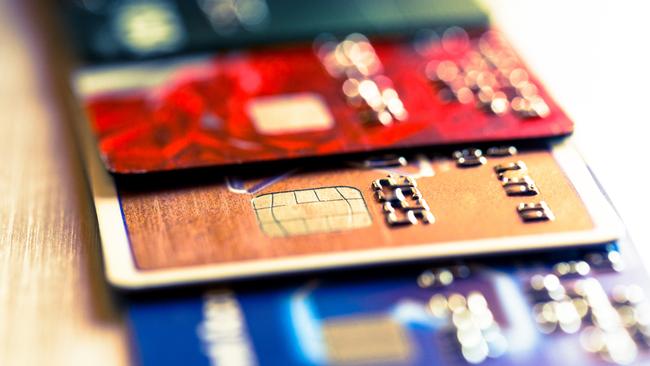Why new bank cards will see you paying more, not less
Two years on from the royal commission it seems the banks have learnt nothing with the release of their latest ‘innovation’ in credit cards. Despite promises of no interest and no annual fees, here’s why you shouldn’t be fooled, writes Terry McCrann.

Terry McCrann
Don't miss out on the headlines from Terry McCrann. Followed categories will be added to My News.
There’s been a lot of water – and money – under the proverbial bridge since that glorious day way back in 1974 when all the banks in Australia mailed out, totally unasked, their ‘Bankcard’ to all their customers and in doing so brought the ‘credit card’ Down Under.
Until then only the ‘selected few’ had what were – and still are – known as ‘charge cards’: American Express and Diners.
They were purely, for want of a better word, transactional: they enabled you to pay with the card, but you had to pay the card balance off in full every month – there was no ‘credit’ given to you. Indeed, it would have been illegal, as only ‘banks’ were allowed to give credit.
For everyone else, for the great majority of Australians – including young ‘men’ taking young ‘women’ out on their first ‘date’; ah, I remember it still – you had to pay in cash, for any and everything. But suddenly there was an alternative – the soon-to-be ubiquitous credit card.
And the rest would be history, including in time similarly ubiquitous poker machines (except, interestingly, and to the great credit of politicians there of both colours, WA) – which joined with credit cards to fleece the financially unsophisticated and those who could least afford the costs.
Now, some 36 years later, we are seeing the first great ‘innovation’ in the credit card – the ubiquitous ‘Bankcard’ has of course long since been replaced by the Tweedledum Visa and Tweedledee MasterCard.
It is an ‘innovation’, which quite frankly could have been, should have been, left un-innovated. Two years after the Banking Royal Commission, it shows that bankers, like the Bourbons – in the words of the great (and interesting) Talleyrand – have “learned nothing and forgotten nothing”.
For very simply the ‘new card’ – launched separately last week by first NAB and then the CBA – does one of two things.
The first is, well, nothing. It is a card that it would be utterly pointless to get and to use.
The second is that it would charge you – and the ‘you’ means either the financially illiterate or the financially desperate – even more usurious rates of interest than you are normally charged on credit (with the emphasis, on credit) cards.
NAB, which went first, dubbed its the “StraightUp” card – showing once again the unwisdom of spending large sums for ‘expert advice’. Pray tell: ‘straight up’ what part of the human anatomy?
CBA followed with its more sensibly, neutrally, name “CommBank Neo”.
In the way of these things they are (almost) exactly the same. As they have to be: it’s not just banks ‘refusing to compete’; it’s because money and especially big bank money is what’s called ‘fungible’. Former economist and current ACCC chairman Rod Sims might care to relearn that.
Both offer three credit limits: $1000, $2000 and $3000. For various reasons, there is no way they’d be offering the $10,000, $20,000, and so on limits of ‘normal’ credit cards.
Both stressed there were “no interest payments, no late payments, no foreign currency fees” – NAB added in its PR blurb “no interest always” and “no annual fee”.
So, wunderbar!; the long-awaited ‘free lunch’ has arrived and it has been delivered by your friendly big banker.
Did I forget to mention the ubiquitous asterisk? You get all this ‘free and gratis’ by paying a monthly fee. It’s almost too small to even mention, but I will anyway.
The fee is $10/ $12 for a $1000 limit; $15/$18 for a $2000 limit; $20/$22 for a $3000 limit – the NAB charges are listed first; the CBA’s second. The CBA charges more because it’s got some extra ‘benefits’.
Everything turns on that fee. If you use the card, you pay it; if you don’t use it, you don’t.
So option one is to have a card that you never use. Well, that’s, useful: I don’t think.
Option two is that you use it; and then you get whacked and whacked big time. You spend $100 over a month; you pay a $10/$12 ‘fee’. That’s an effective interest rate that runs well into triple digits and makes payday lenders look like charities.
Unlike a ‘normal’ credit card, you can’t save some of the pain by paying it off early. You spend $100 on Monday and pay it off on Tuesday and you will still get charged the $10/$12 fee.
We could go on: the only way you can ‘save’ is to go straight to your limit and pay it off at the minimum each month. Then you get effectively a personal loan at an effective rate in the low double-digits.
But what’s the utility in that? Using it as a normal credit card means the financially illiterate and the financially desperate paying at least the same high rates as ‘normal’ cards.
Oh, and one last thing: who ‘launched’ Bankcard – and so rapaciously ubiquitous credit cards into Australia? None other than the greatest hero of the Australian left: someone called Gough Whitlam.
MORE TERRY MCCRANN:
NOTHING CAN HEAL RIFT BETWEEN LEW AND MYER CEO
OPINION: WHY ANDREWS MUST RESIGN NOW
WHY CUTTING SUPER IS POLITICAL SUICIDE
Originally published as Why new bank cards will see you paying more, not less

